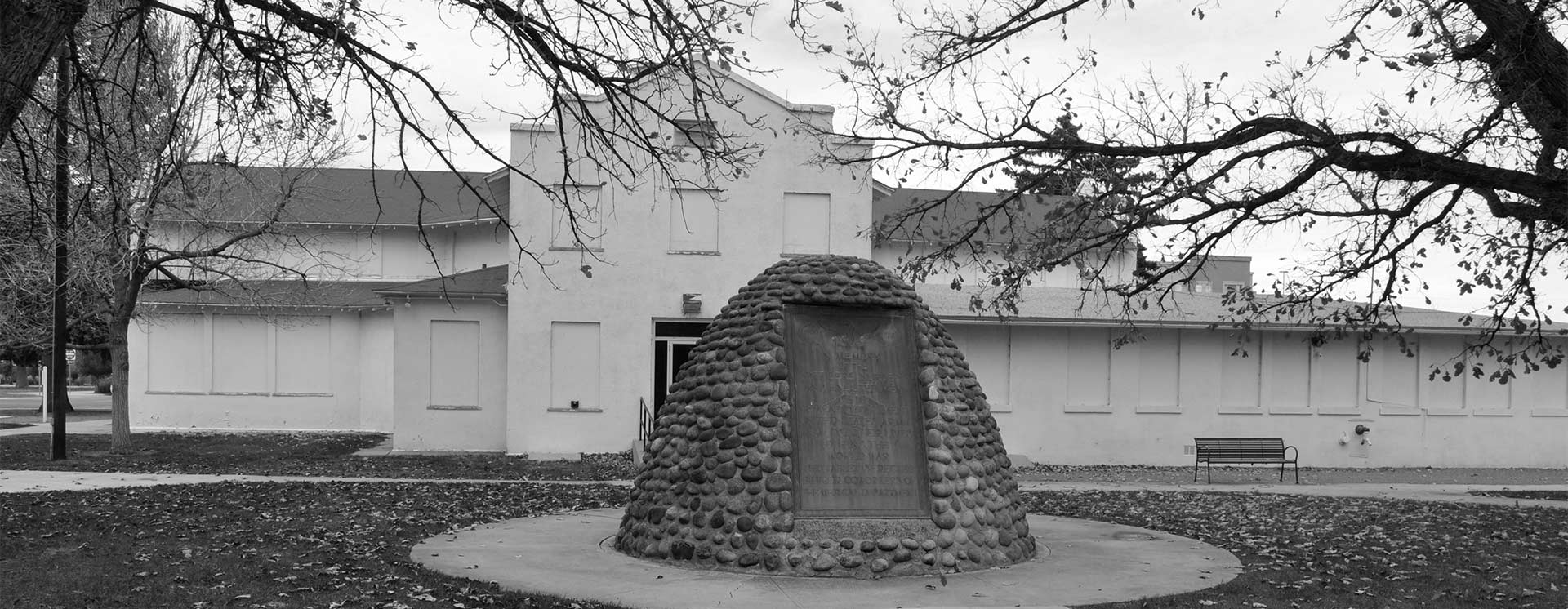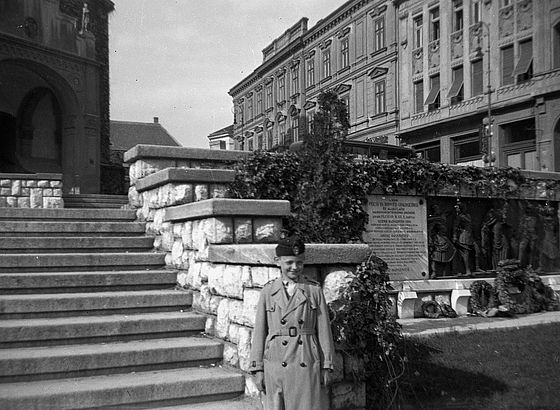
World War One Sites - The NETWORLD Database
19th Aircraftman Infantry Regiment
The relief made of bronze by Ferenc Sidló. Originally there were marbles at both side of the relief, but after 1945 one of them was removed in unknown circumstances.
It's placed in the main square of Pécs. The inauguration of the memorial was held in the 5th of June in 1932. It was built into the parapet that surrounds the inner space. There are five figures on the relief arranged perfectly symmetrically. The allegorical figure in the middle wears a clothes that reaching the ground with a cloak on his shoulder and with the Holly Crown of Hungary on his head. He holds a sword in his right and a laurel wreath in his left arm. There are two-two other figures on both of his sides: on the left edge a pagan ancient Hungarian gallant; next to him a hussar with a naked sword and with an armoured shield in his hands. On the right edge a Scythian warrior next to him an infantryman with helmet holding a shield with the crest of Pécs on it. The posture of these figures are nearly the same, as a reflections of each other. Their movements are pathetic and considered. The artist used the well-known Egypt method instead of the usual baroque illusionary foreshorten, therefore the limbs are twisted and their pose are significantly stiff.
Hungary, Hungary
Type of WWI-heritage
- War monument
Dimensions
State of repair/preservation
protected
(Ruled by the Act LXIV of 2001 : https://net.jogtar.hu/jr/gen/hjegy_doc.cgi?docid=a0100064.tv )
Historical WWI Context
The inauguration of the memorial was held in the 5th of June in 1932 together with the 52nd Aircraftman Infantry Regiment Memorial which is next to it. Originally there were a marble tablet on both sides of the relief. The one from the right side has been removed in unknown circumstances after 1945.
The 19th Aircraftman Infantry Regiment were mobilized on 25th of July in 1914. After the battle of the Piave River that produced significant casualties the regiment was broken up on the 18th of November 1918.
State of legal protection
Renewed and replaced in 2010
Owner
Public property
Kind of cultural use of WWI
No information available.
Opening
The Baka Museum in Szekszárd is open Saturdays 9.00-13.00
Other visiting opportunities may be arranged for groups or non-locals by contacting György Borbandi (tel.: +36302260868, e-mail: bbander@freemail.hu) or Zoltán Tálosi (tel.: +36304571022, e-mail: repulos@hotmail.com)
For more information about “Új világ született” exhibition visit:
http://ujvilagszuletett1.elsovilaghaboru.com/en/visitor-information
The Museum of Military History is opened from Tuesday till Sunday, form 9.00 – 17.00.
(tel: +36 1 325-1600; e-mail: webmaster@mail.militaria.hu )
Entrance Fee
Entry to the Baka Museum in Szekszárd is free of charge, the entry to “Új világ született” exhibition is 3000 HUF, while the entry to the Museum of Military History is 1.500 HUF.
Information regarding cities, villages, other touristic attractions (non-WWI) nearby
Pécs is palced in Barany County, that lies between the Danube and the Dráva rivers. Baranya is divided between Hungary and Croatia with the majority of the region lying in Hungary.The city of Pécs is home to countless tourist attractions. It has been inhabited since the Roman ages, when it was called Sopianae. One of the main tourist attractions is the Early Christian Cemetery which was added to the UNESCO World Heritage List in 2000. This heritage site can be accessed through the Cella Septichora Visitor’s Centre. Medieval relics can be found in the Dóm Museum. The present neo-romanesque cathedral was built at the end of the 19th century. During the 16th century Pécs was occupied by the Turkish, and the modern cityscape has preserved some of its built heritage. The main attraction is the mosque of pasha Gazi Kasim, which is found on the main square (Széchenyi tér) of the city. Another important element of Pécs’ heritage is Zsolnay porcelain, their legacy being carried on and rejuvenated by the founding of the Zsolnay Cultural Quarter, which has become a new cultural scene in the city. Further tourist information about Pécs can be found at: http://www.iranypecs.hu/en/ and http://www.zsolnaynegyed.hu/
Accomodation
Various providers in broad range of categories can be found at: booking.com
Search: Pécs, (Baranya, Hungary)
Public Transport
Pécs can be accessed by train and coach also. InterCity trains leave from Budapest, Keleti pályaudvar (Eastern railway station) every two hours. The trip is 3 hours long. Timetables can be found at https://www.mavcsoport.hu/en. Coaches leave from Népliget Bus Terminal (https://www.volanbusz.hu/en/travel-information/our-stations/budapest#nepliget), the trip is about 4 hours long. Coach timetables can be found at www.menetrendek.hu and clicking on “csak Volán járatok”.
Further information sources
Other heritage sites nearby
Museums Private Collections
There is a museum in Szekszárd (60 km north of Pécs in Tolna county) dedicated to the infantryman of Tolna county who served in the 1st and 2nd World Wars. It is the private collection of György Borbandi and Zoltán Tálosi that has been made available for public viewing. Hungarian language website: http://bakamuzeum.hupont.hu/
Address: Béla király tér 1., Vár köz, 7100 Szekszárd
„Új világ született“(„A New World Was Born“) permanent exhibition guides visitors from the belle époque through wartime enthusiasm to bitter disillusionment on over 600 square metres. The exhibition brings the horrors of war closer to the spectators of today with the help of exceptional visual devices.
Address: Várkert Bazár, Dél Palota, Ybl Miklós Square 6., 1013 Budapest
There is another permanent exhibition in the Museum of Military History in Budapest with the title, „Hungary in the Great War 1914-1918“.
Address: Kapisztrán Square 2-4, 1014 Budapest
19th Aircraftman Infantry Regiment
46.076907 18.228060 fileadmin/res/images/layout/standar-marker.pngLocation

